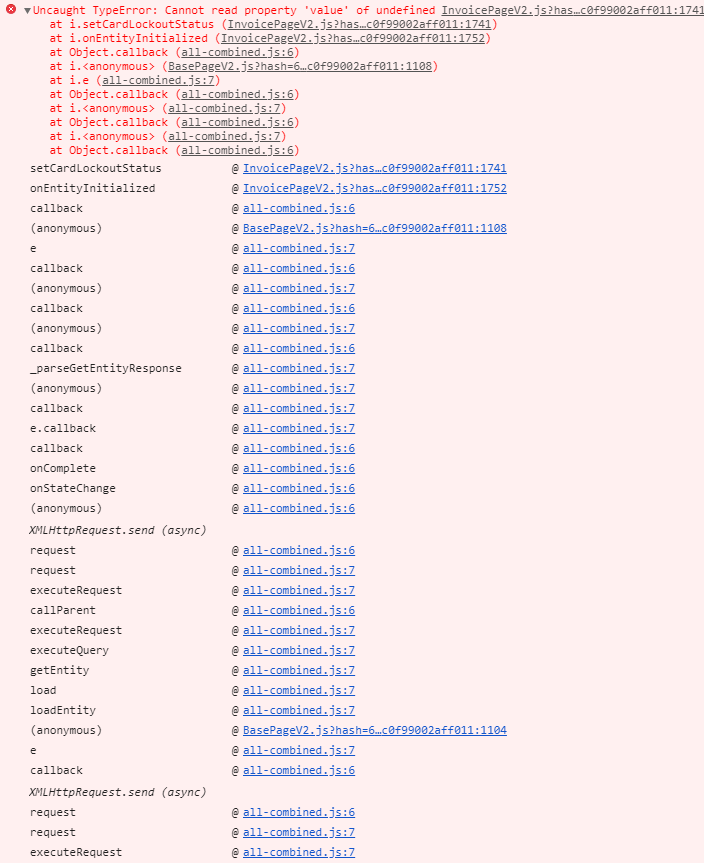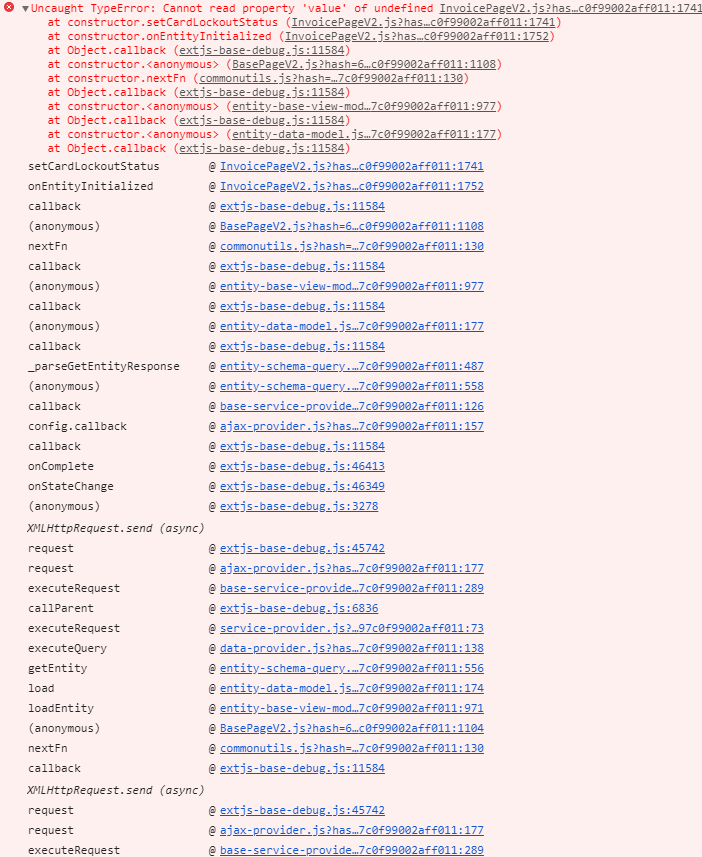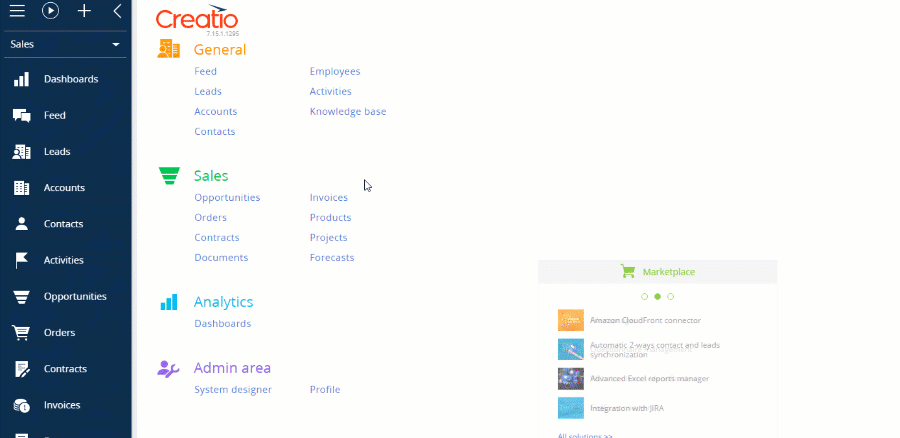Front-end debugging tools overview
Front-end debugging is debugging of Creatio front-end implemented in configuration element schemas of the Client module type. Learn more in a separate article: Client module.
Integrated debugging tools
Debug the front-end from the browser directly. To do this, use integrated developer tools provided by all supported browsers. All browsers provide similar debugging tools. Learn more in the official Google Chrome documentation, official Microsoft Firefox documentation, official Microsoft Edge documentation, and official Apple Safari documentation.
You can open the debugging tools in the following ways:
- Press
F12orCtrl+Shift+Iin Google Chrome - Press
F12in Microsoft Firefox - Press
F12in Microsoft Edge
Scripts and breakpoints
The development tools let you view the complete list of scripts that are connected to the page and downloaded to the client. You can set a breakpoint wherever you want the code to stop.
To set a breakpoint:
-
Find the needed script file (you can do it by pressing
Ctrl+OorCtrl+P) and open it. -
Go to the code line to set the breakpoint. For example, you can search for a method by name.
-
Set a breakpoint.
You can set a breakpoint in the following ways:
- click the line number
- press
F9 - click Add breakpoint in the context menu
You can also set a conditional breakpoint which lets you set acondition that triggers the breakpoint.
Use the debugger command to suspend the execution of a script directly from the code.
function customFunc (args) {
...
debugger; // <-- Debugger stops here.
...
}
You can view the current values of the variables, execute commands, etc. after the code execution is suspended.
Manage front-end debugging
Check the values of the call stack variables after the code execution is suspended. Then, trace code for fragments where the actual program behavior differs from the expected.
View the browser debugger commands that let you navigate the code step by step in the table below.
Browser debugger commands
Command | Browser | ||
|---|---|---|---|
Pause script execution (1) | + | + | + |
Step over next function call (2) | + | + | + |
Step into next function call (3) | + | + | + |
Step out of current function (4) | + | + | + |
Deactivate breakpoints (5) | + | – | – |
Pause on exceptions (6) | + | – | – |
Learn more about the features and commands of the browser navigation bar in the official documentation.
Browser console actions
You can execute the following actions at the browser console:
- call JavaScript commands
- display debugging information
- display trace information
- measure and profile code
To do this, use the console object.
Call JavaScript commands
- Open the browser console. To do this, open the Console tab. To open the Console tab besides the debugger, click
Esc. - Enter JavaScript commands at the console.
- Press
Enterto execute the commands.
Display debugging information
The console can display the following debugging information:
- information messages
- warnings
- error messages
To display debugging information, use the corresponding methods of the console object listed in the table below.
Methods of the console object
Method | Description | Browser | ||
|---|---|---|---|---|
Google Chrome | Microsoft Firefox | Microsoft Edge | ||
| Displays comma-separated parameters at the console. Required to display various general-purpose messages. | + | + | + |
| Similar to the | + | + | + |
| Displays a warning at the console. | + | + | + |
| Displays an error message at the console. | + | + | + (8+) |
The console applies a unique style to each message type.

The methods of the console object let you format console messages. You can use special control sequences (templates) in the message text. The templates are replaced by the corresponding values when displayed. The values are also transferred to the function in order of appearance.
View the formatting templates for the methods of the console object in the table below.
Formatting templates for the methods of the console object
Template | Data type | Use case |
|---|---|---|
| String |
|
| Number |
|
| Float |
|
| DOM element (not supported by Microsoft Edge) |
|
| JavaScript object (not supported by Microsoft Edge, Microsoft Firefox) |
|
| CSS style (not supported by Microsoft Edge) |
|
Display trace information
View the browser console methods that let you trace and verify expressions in the table below.
Browser console methods that trace and verify expressions
Method | Description | Browser | ||
|---|---|---|---|---|
Google Chrome | Microsoft Firefox | Microsoft Edge | ||
| Displays the call stack from the breakpoint and calls the method. The call stack contains file names, line numbers, and a count of | + | + | + (11+) |
| Checks the expression passed as the | + | + (28+) | + |
var myArray = new Array();
/* Activate the counter with Initialize myArray tag. */
console.time("Initialize myArray");
myArray[0] = myArray[1] = 1;
for (i = 2; i < 10; i++) {
myArray[i] = myArray[i - 1] + myArray[i - 2];
}
/* Deactivate the counter with Initialize myArray tag. */
console.timeEnd("Initialize myArray");
View the browser console methods that let you profile code and display the profiling stack in the table below. The profiling stack contains detailed information about the time it takes the browser to execute the operation.
Browser console methods that measure code execution time
Method | Description | Browser | ||
|---|---|---|---|---|
Google Chrome | Microsoft Firefox | Microsoft Edge | ||
| Runs a JavaScript profiler, then displays the result using the | + | + (if the DevTools panel is open) | + (10+) |
| Stops the JavaScript profiler. | + | + (if the DevTools panel is open) | + (10+) |
The profiling results are displayed in the following browser tabs:
- Profiles in Google Chrome
- Performance in Microsoft Firefox
- Profiler in Microsoft Edge
Front-end debugging mode isDebug
The front-end debugging mode isDebug lets you retrieve detailed information about Creatio errors and track them in the code.
Browser minifies code in regular mode. This means client scripts are assembled in the all-combined.js file. The file is assembled when the assembly is created and contains the entire functionality. If you enable isDebug mode, the assembly and minification of *.js files are turned off. Client scripts are displayed as separate files.
Front-end debugging mode affects Creatio performance. For example, it increases the time it takes to open pages.
To configure front-end debugging mode:
-
Identify the current status of the front-end debugging mode. To do this, press
F12orCtrl+Shift+Iin Google Chrome.Besides the status of the front-end debugging mode, the console displays a code to activate or deactivate it.

-
Enable front-end debugging mode.
You can enable front-end debugging mode in the following ways:
-
Refresh the page or press
F5to apply the changes.
Creatio displays a Debug indicator next to the version number after you turn on front-end debugging mode.

View the examples that display error information in the console when isDebug mode is turned on and off on the figures below.


Resources
Official Google Chrome documentation (description of developer tools)
Official Microsoft Firefox documentation (description of developer tools)
Official Microsoft Edge documentation (description of developer tools)
Official Apple Safari documentation (description of developer tools)



